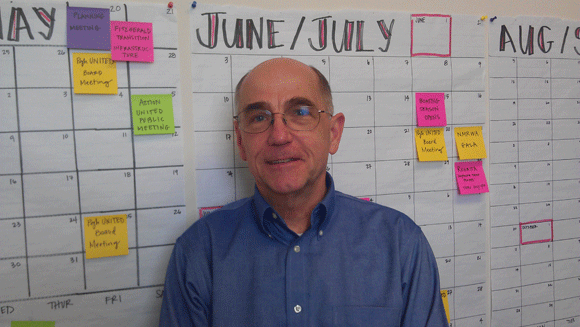Across the United States, many believe that a four-year college education is essential to a successful and rewarding career. But when it comes to economic revitalization on the community level, a growing number of stakeholders believe its actually the oft-forgotten middle-skills workforce that will drive the road to recovery.
Middle-skill jobs, which require education beyond high school but not a four-year degree, make up the largest part of the labor market in the United States. According to the National Skills Coalition, middle-tier employment accounted for 54 percent of the U.S. labor market in 2012. In Pennsylvania in 2012, 55 percent of all occupations were middle-skill.
The state also matched another more unfortunate nationwide trend: Only 44 percent of Pennsylvania's workers were trained to the middle-skill level. Should this “skills gap” continue to widen, it will keep the state's economy from growing and employers from hiring.
Local advocates cite a need for leaders from the business, education and political spheres to act in concert to restore the state's middle-skills ranks. Job-driven policies and alignment of workforce and education investments with employer needs are among the strategies that could boost the number of jobs in essential sectors such as manufacturing, energy, health care and IT.
A STEM catalyst
Key industries throughout the country are unable to find enough sufficiently trained workers to fill jobs. A Harvard Business School study reported that 75 percent of manufacturers are experiencing a moderate to severe shortage of talent — approximately 600,000 manufacturing sector jobs consistently remain open. Statewide, 41 percent of companies surveyed in a 2012 report from Pennsylvania Chamber of Business and Industry said they have trouble finding workers with the required technical training.
Recognizing the importance of bolstering the local workforce via upskilling and educational access, Chevron Corporation launched its Appalachia Partnership Initiative last October. The $20 million venture is designed to tackle the skills gap in 27 counties across southwestern Pennsylvania, northern West Virginia and eastern Ohio, says Trip Oliver, manager of policy, government and public affairs at the energy and tech company's Pittsburgh office.
In collaboration with partners including the Allegheny Conference on Community Development, Chevron has committed to a long-term improvement of science, technology, engineering and math (STEM) education to aid the development of a highly trained labor force for area energy and manufacturing industries.
A concentration on STEM makes sense for Pittsburgh, says Oliver, considering that the 10-county region's energy sector is home to almost 1,000 companies and 41,000 jobs, leading to a $19 billion economic impact, according to a 2012 study from the Allegheny Conference on Community Development.
“Our role is as a catalyst to address the skills gap in the workforce,” explains Oliver.
That effort includes expanding an existing partnership with Project Lead the Way, a STEM proponent group that builds tech programs at area K-12 schools through curriculum resources and teacher training. In 2015, 20 programs will be added to the 10 already in existence at school districts in Pennsylvania and the other two states affected by the overarching initiative.
Chevron will also partner with ShaleNet, a workforce training program for the oil and natural gas industry, to provide scholarships to students at four community colleges in the tri-state region, including Westmoreland County Community College. ShaleNet programming will connect participants to post-secondary opportunities and skilled trade certifications.
The initiative is holistic, meaning a student could create a pathway into a STEM-related career starting in junior high, says Oliver.
“These are not your grandfather's blue-collar jobs,” he adds. “You're going to need a foundation of science and math. The idea is to make these kids competitive for the available work.”
Underground economic development
Pittsburgh UNITED envisions skilled job opportunities taking place underneath the population's feet thanks to the Clean Rivers Campaign. The social and economic advocacy nonprofit is a vocal supporter of efforts to promote family-sustaining employment and green infrastructure improvements via the city's $2 billion stormwater management plan.
“Green” methods as rain gardens, retention ponds, swales and permeable pavement not only mitigate runoff, but create sustainable, accessible work without the need for years of apprenticeship, explains Pittsburgh UNITED Executive Director Barney Oursler. The nonprofit is one of several groups to endorse the program created to raise awareness of the sewage overflow issues in Allegheny County.
Green infrastructure would take the burden off the enormous subterranean tunnels currently included in the Allegheny County Sanitary Authority (ALCOSAN) stormwater system upgrade, thought to be the largest public works project in county history.
“Building and maintaining tunnels is high-skilled work with years of training needed,” says Oursler. “Moving earth to control water flow or replanting rain gardens require different skills. Instead of six years of apprenticeship you may need six months.”
An environmentally-friendly sewer plan could create hundreds of middle-skills jobs, boosting lower-income communities that wouldn't have access to the complex construction careers that come with the “grey” infrastructure of installing concrete, explains Oursler.
Pittsburgh UNITED is attempting to garner backing from the Keystone Research Center to determine exactly how many jobs green construction would create. Support from City Hall would further help the cause, notes the nonprofit director.
“This is a project that we would need political support for,” he insists.
Focusing on employer needs
Community support nonprofit Neighborhood Allies takes an investment approach to job development. They connect funders to organizations such as regional financial opportunity centers that provide citizens with employment services and financial education.
Three new centers are set to open early this year, all built around the Local Initiatives Support Corporation (LISC) model of stimulating economic growth in healthy communities.
A center run by the Oakland Planning and Development Corporation, for example, will offer training for certified nurses and home health aides, notes Talia Piazza, Neighborhood Allies program manager.
The Pittsburgh nonprofit also provides grants for ideas that enhance the region. A $75,000 grant was given to the Trade Institute of Pittsburgh, which teaches students masonry and other construction skills that can help pull them out of the minimum wage job market.
Job training must focus on employer needs, explains Sarah Dieleman Perry, manager for economic opportunity at Neighborhood Allies. With Marcellus Shale drilling creating an energy hub in the area, the group has given support to the Mentors Community Wealth Building Initiative, a corporate-funded program training young adults for careers in the oil and gas industry.
“This is a growing field with a ton of employment opportunities,” says Dieleman Perry.
As a whole, middle-skills jobs encompass a huge array of occupations. The Harvard report found almost 7.3 million middle-tier online job postings in 2013 out of a total of 19.9 million postings. Continued education, advocacy and civic engagement will be needed to connect talent to positions that sometimes fall through the cracks.
“Pittsburgh has redesigned itself from a steel town to an emphasis on health care and education,” says Piazza. “There's a need for those trades.”




